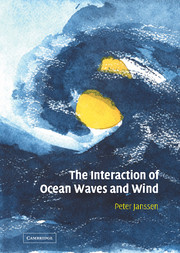3 - On the generation of ocean waves by wind
Published online by Cambridge University Press: 06 October 2009
Summary
In this chapter the theory of the generation of oceanwaves by wind will be developed resulting in an expression for the wind-input source function Sin of the action balance equation. As will be seen from the subsequent discussion, this problem has led to many debates and much controversy. There may be several reasons for this. On the one hand, from the theoretical point of view it should be realized that one is dealing with an extremely difficult problem because it involves the modelling of a turbulent airflow over a surface that varies in space and time. Although there has been much progress in understanding turbulence over a flat plate in steady-state conditions, modelling attempts of turbulent flow over (nonlinear) gravity waves are only beginning and, as will be seen, there is still a considerable uncertainty regarding the validity of these models.
On the other hand, from an experimental point of view it should be pointed out that it is not an easy task to measure growth rates of waves by wind. First of all, one cannot simply measure growth rates by studying time series of the surface elevation since the time evolution of ocean waves is determined by a number of processes such as wind input, nonlinear interactions and dissipation. In order to measure the growth of waves by wind one therefore has to make certain assumptions regarding the process that causes wave growth.
- Type
- Chapter
- Information
- The Interaction of Ocean Waves and Wind , pp. 56 - 128Publisher: Cambridge University PressPrint publication year: 2004
- 1
- Cited by



